 Romanian master Lucian Pintilie constructs a “Theatre of the Absurd” darker and more acerbic than any from Eugene Ionesco’s imagination. You would be hard-pushed indeed to find any opening scenes more compelling that those of THE OAK in cinema, in which Nela, a female psychologist, watches home movies with her dying father, in her small apartment crammed with toppling artefacts of communism.
Romanian master Lucian Pintilie constructs a “Theatre of the Absurd” darker and more acerbic than any from Eugene Ionesco’s imagination. You would be hard-pushed indeed to find any opening scenes more compelling that those of THE OAK in cinema, in which Nela, a female psychologist, watches home movies with her dying father, in her small apartment crammed with toppling artefacts of communism.
Pintilie’s powerful grasp of the theatrical helps to create a manifestation of her internal state within the confined physical space. The central theme of the film is established here as reality attempts to force its way into this space and disrupt the precarious balance of illusory reality she has created. The death throes of Ceausescu’s Romania are the focus of the work. One example illustrates the seemingly wilful illogicality of the regime – the dead are buried “in eternal glory”, but lack of medical facilities means that their organs can not be used for transplantation.
As with Picasso’s Guernica, THE OAK transcends narratives of the human condition to also contextualise Pintilie’s personal experiences and confused relationship with his homeland.
Nela meets a doctor Mitica, – tempest of a man- and together they confront and challenge authority, conformity and complicity in the as they travel through the landscape of the sclerotic utopia of communist Romania. As with Picasso’s Guernica, THE OAK transcends narratives of the human condition to also contextualise Pintilie’s personal experiences and confused relationship with his homeland. It forces us to question the nature of normality and abnormality, as well as our willingness to meet out harsh truths, and our unwillingness to hear them. It lurches towards madness as society’s self-erected barricades can no longer withstand pressure of reality and ends with a scene which manages to be simultaneously romantic, challenging and chilling.

